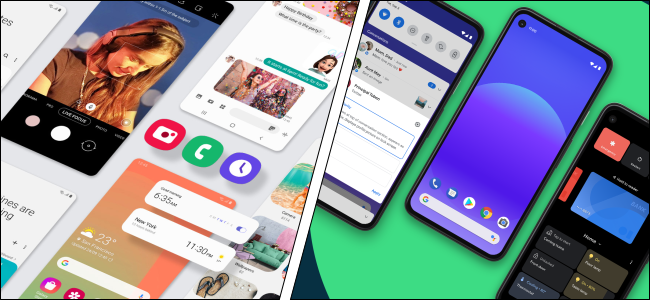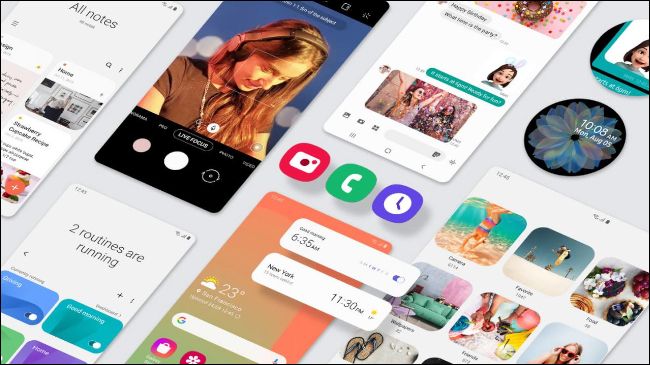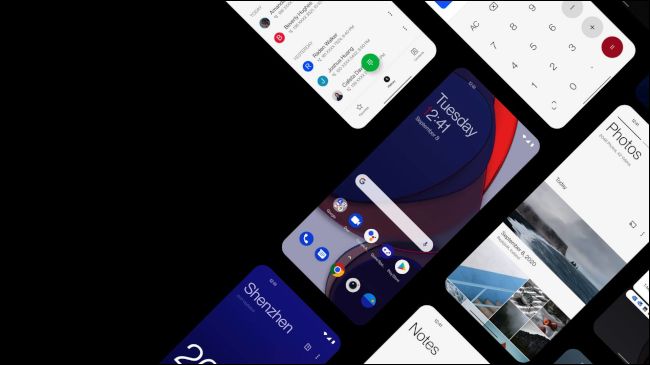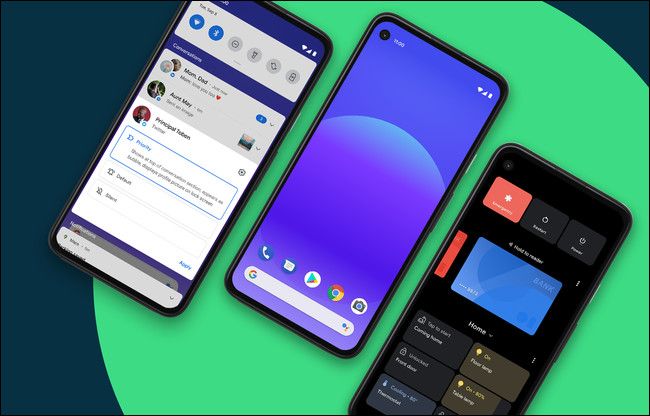Quick Links
Have you ever noticed that Android on a Samsung phone doesn't look like Android on a Google Pixel phone? Both use the same operating system, but look completely different. What's the deal with that?
Android Device Manufacturers Love Skins
Not all Android devices look the same, but we're not just talking about the physical appearance of the hardware. Many manufacturers that produce Android devices use their own custom "skins" to make the operating system look unique.
There are a few things you'll have to understand about Android before we dive into skins specifically. We'll explain what exactly skins are, why manufacturers are allowed to modify Android, and what it all means for the Android ecosystem as a whole.
What Is "Stock" Android?
Before we get to the skins, it's important to understand the OS at its core. Android is an open-source operating system developed by Google. The "open-source" part is what makes Android skins possible.
Google makes changes and updates to Android, and then releases the source code to the Android Open Source Project (AOSP). This original code is what many refer to as "stock" or "vanilla" Android because it's a very bare-bones version.
Manufacturers, like Samsung, LG, OnePlus, and others, start with stock Android. However, because Android's code is open-source, they're free to modify it to their liking. If they want to include Google apps and services on their devices, though, they must first meet a few requirements.
When a new version of Android is released, it's up to manufacturers to customize it and send it to their own devices. Google isn't responsible for updating all Android devices. Stock Android is simply the starting point on which other companies can build.
What Is an Android Skin?
An Android skin is most easily described as a modified version of stock Android. Here are some of the most popular Android skins:
- Samsung One UI
- Google Pixel UI
- OnePlus OxygenOS
- Xiaomi MIUI
- LG UX
- HTC Sense UI
There are varying levels of modification when it comes to Android skins. For example, Google Pixel devices don't run stock Android, but Google's user interface (UI) customizations are fairly minimal. Samsung Galaxy devices, on the other hand, run "One UI," and they look quite a bit different than stock Android.
Here's the thing, though: Android skins are really much more than just "skins." They're all actually a unique version of the Android operating system.
Samsung's One UI is probably the most widely used Android skin. Everything from the Settings menu and the lock screen, to the notification shade, has been customized in some way. This is the case with most Android skins---the most noticeable customizations are on the surface.
However, skins are more than just aesthetics. Samsung phones have many software features you won't find on other devices. For example, the Samsung Galaxy Fold has tons of custom features for its folding display. Skins allow a manufacturer to not only customize the look, but also throw in special features to differentiate its devices.
As we mentioned above, manufacturers must meet certain requirements if they want to include the Google Play Store and other Google services on their devices. Google sets these requirements so Android apps will work consistently across different skins.
This is why Android devices that ship with Google services generally work the same. They might look very different, but, for the most part, everything will be where you expect it to be. This also means if you switch from a Samsung Galaxy phone with One UI to a OnePlus with OxygenOS, all your apps will still work.
The main takeaway here is that an Android skin is simply a modified version of the Android operating system. Still, if an Android device is going to include Google services, those modifications can only go so far.
Does an Android Skin Slow Down Updates?
Skins are often a subject of debate when it comes to timely updates. Many Android devices don't receive the latest updates until several months after Google releases them. But are skins to blame for this problem? Well, kind of.
As we explained above, when Google releases an Android update, the company shares the source code with the Android Open Source Project. It's then up to the device manufacturers to make their custom modifications and send it off to their devices.
Google has an advantage here, as it makes Pixel devices and the software changes are minimal. It's easy for Google to send the latest updates to Pixel devices as soon as they're available. Manufacturers like Samsung, however, have more work to do.
More Than Skin Deep
Android skins are more than just skins. Try not to think about the Android version number as much as the version of the "skin" you're using. Perhaps your Samsung device isn't on the latest version of Android, but there's a good chance it has the latest version of Samsung's One UI.
For example, Amazon devices are many Android versions behind, but no one cares. People care more about being on the latest version of Fire OS than the latest version of Android. It's helpful to think of One UI, OxygenOS, and other skins in the same way.
If you'll always need the latest Android release as soon as possible, a Google Pixel phone is the way to go. All other devices will always lag behind a bit, but, as we covered above, for most folks, that won't be a big deal.





